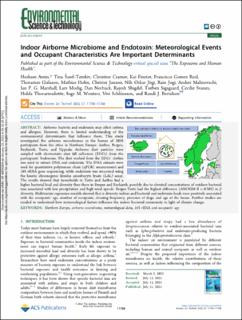| dc.contributor.author | Abouelhana, Hesham Amin Mohamed | |
| dc.contributor.author | Šantl-Temkiv, Tina | |
| dc.contributor.author | Cramer, Christine | |
| dc.contributor.author | Finster, Kai | |
| dc.contributor.author | Gomez Real, Francisco | |
| dc.contributor.author | Gislason, Thorarinn | |
| dc.contributor.author | Holm, Mathias | |
| dc.contributor.author | Janson, Christer | |
| dc.contributor.author | Jögi, Nils Oskar | |
| dc.contributor.author | Jogi, Rain | |
| dc.contributor.author | Malinovschi, Andrei | |
| dc.contributor.author | Marshall, Ian P. G. | |
| dc.contributor.author | Modig, Lars | |
| dc.contributor.author | Norbäck, Dan | |
| dc.contributor.author | Shigdel, Rajesh | |
| dc.contributor.author | Sigsgaard, Torben | |
| dc.contributor.author | Svanes, Cecilie | |
| dc.contributor.author | Thorarinsdottir, Hulda | |
| dc.contributor.author | Wouters, Inge M. | |
| dc.contributor.author | Schlünssen, Vivi | |
| dc.contributor.author | Bertelsen, Randi Jacobsen | |
| dc.date.accessioned | 2024-03-22T14:08:47Z | |
| dc.date.available | 2024-03-22T14:08:47Z | |
| dc.date.created | 2023-10-10T13:57:32Z | |
| dc.date.issued | 2023 | |
| dc.identifier.issn | 0013-936X | |
| dc.identifier.uri | https://hdl.handle.net/11250/3123915 | |
| dc.description.abstract | Airborne bacteria and endotoxin may affect asthma and allergies. However, there is limited understanding of the environmental determinants that influence them. This study investigated the airborne microbiomes in the homes of 1038 participants from five cities in Northern Europe: Aarhus, Bergen, Reykjavik, Tartu, and Uppsala. Airborne dust particles were sampled with electrostatic dust fall collectors (EDCs) from the participants’ bedrooms. The dust washed from the EDCs’ clothes was used to extract DNA and endotoxin. The DNA extracts were used for quantitative polymerase chain (qPCR) measurement and 16S rRNA gene sequencing, while endotoxin was measured using the kinetic chromogenic limulus amoebocyte lysate (LAL) assay. The results showed that households in Tartu and Aarhus had a higher bacterial load and diversity than those in Bergen and Reykjavik, possibly due to elevated concentrations of outdoor bacterial taxa associated with low precipitation and high wind speeds. Bergen-Tartu had the highest difference (ANOSIM R = 0.203) in β diversity. Multivariate regression models showed that α diversity indices and bacterial and endotoxin loads were positively associated with the occupants’ age, number of occupants, cleaning frequency, presence of dogs, and age of the house. Further studies are needed to understand how meteorological factors influence the indoor bacterial community in light of climate change. | en_US |
| dc.language.iso | eng | en_US |
| dc.publisher | ACS | en_US |
| dc.rights | Navngivelse 4.0 Internasjonal | * |
| dc.rights.uri | http://creativecommons.org/licenses/by/4.0/deed.no | * |
| dc.title | Indoor Airborne Microbiome and Endotoxin: Meteorological Events and Occupant Characteristics Are Important Determinants | en_US |
| dc.type | Journal article | en_US |
| dc.type | Peer reviewed | en_US |
| dc.description.version | publishedVersion | en_US |
| dc.rights.holder | Copyright 2023 The Author(s) | en_US |
| cristin.ispublished | true | |
| cristin.fulltext | original | |
| cristin.qualitycode | 2 | |
| dc.identifier.doi | 10.1021/acs.est.3c01616 | |
| dc.identifier.cristin | 2183392 | |
| dc.source.journal | Environmental Science and Technology | en_US |
| dc.source.pagenumber | 11750-11766 | en_US |
| dc.relation.project | Norges forskningsråd: 274767 | en_US |
| dc.identifier.citation | Environmental Science and Technology. 2023, 57 (32), 11750-11766. | en_US |
| dc.source.volume | 57 | en_US |
| dc.source.issue | 32 | en_US |

